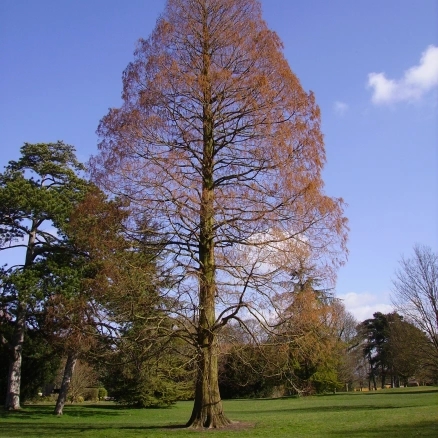Muffled up and walking in the park, that bright harshly cold midwinter morning I was horrified to see what had happened to the Sequoias.
I’d identified three Sequoias, or Redwood trees, in my local park a while back. I’d recognised them by their yew-like needles, their tall regular ovoid profile and red spongy bark, and I checked them out, spoke to them, whenever I passed through the park. But the needles of the Sequoias that winter morning had turned an awful lurid orange, the colour of the underside of a slug, or the nasty neon of cheap orange squash. It was as if they were shedding their needle leaves, yet as far as I knew Sequoias – Coast Redwoods (Sequoia Sempervirens) and Giant Redwoods (Sequoiadendron giganteum) – were all evergreen. I made a concerted effort to call on the Sequoias every few weeks over the rest of the winter and watched in dismay as the trees seemed to wither away and die.
Dawn Redwood in Cherry Hinton Hall Park
I thought and read about Coast and Giant Redwoods a lot for a few months, learning that Sequoias are the largest, tallest and oldest trees on the planet, there is fossil evidence going back 5 million years. And although native to north west coast USA, since the 1860s they have become quite popular transplants in parks and botanic gardens across Europe, indeed Redwoods seem to grow larger, faster and stronger in European soil than in their native habitat. In the website Redwood World (http://www.redwoodworld.co.uk/) I found an invaluable information resource and exchange, with a county by county list of redwoods in the UK, there was no mention of Redwoods in my local park, only trees in the University Botanic garden and newly planted saplings in private gardens.
Although I thoroughly researched Redwoods it wasn’t clear to me why they appeared to be dying, there seemed no evidence of insect infestation and our local park has no large animals, like deer or cattle, to eat the trees, I began to assume environmental failure.
In googling image searches I tried to distinguish the two species and identify which species was dying in my local park. My local specimens were most like the Coast Redwoods (Sequoia Sempervirens), red burnished bark glowing in bright spring leaved green, growing tall, straight and wild in endless sun dappled groves on the internet. I was pretty sure my park Redwoods were not Giant Redwood (Sequoiadendron giganteum) which seem to exist primarily in freak-of-nature type photographs – tiny human standing by stupidly enormous tree, or a cabin made from a single hollowed out log , or tunnelled through for a road, I decided that all those implausibly-giant-tree photographs on the web are either CGI or Giant Redwoods. My redwoods although clearly mature were still small enough to encircle with my arms, small enough to hug.
Then, one solitary park-walk in mid-April I noticed the Sequoias gleaming with that tentative nearly-bursting leaf-bud mild- halo of green, just like the park’s oaks, ashes and conker trees – it looked to me like the Redwoods were miraculously coming back to life. Sequoias resurrected. I spent quite a while with one of the trees, noticing new growth, leaf shapes, patterns and sizes, and then I rushed home, giddy to google “deciduous sequoia”.
That was how I encountered the third member of the Sequoia family – the Dawn Redwood (Metasequoia glyptostrobides), a tree believed to be long extinct, an ancestor to Coast and Giant species , known only as fossils. Then last century a stand of deciduous Sequoias were discovered in China, it took until 1946 for the connection between the Chinese trees and the fossils to be made. To prevent final extinction seeds were gathered in 1948 and distributed to universities, research facilities and botanic gardens around the globe.
The Dawn Sequoia is characterised by its deciduous nature and the leaflets occurring in opposite pairs on the stem, apart from this, for a lay person, there really is nothing to distinguish the Dawn from the Giant or Coast Redwood. The outline of the Dawn and Coast are almost identical and they all bear the distinctive bright spongy red bark.
All three trees in my local park are mature enough to produce cones and to have reached their current size they must have come from the earliest batches of seed distributed in 1948. I have contacted the Cambridge Botanic Gardens and Redwood World website to see their thoughts, and it will be interesting to see if I can discover the story of these three rare trees and how they came to be planted here, in a suburban Cambridge park.
Dawn Redwoods at Cherry Hinton Hall
Jean Dark (first posted June 2015)


